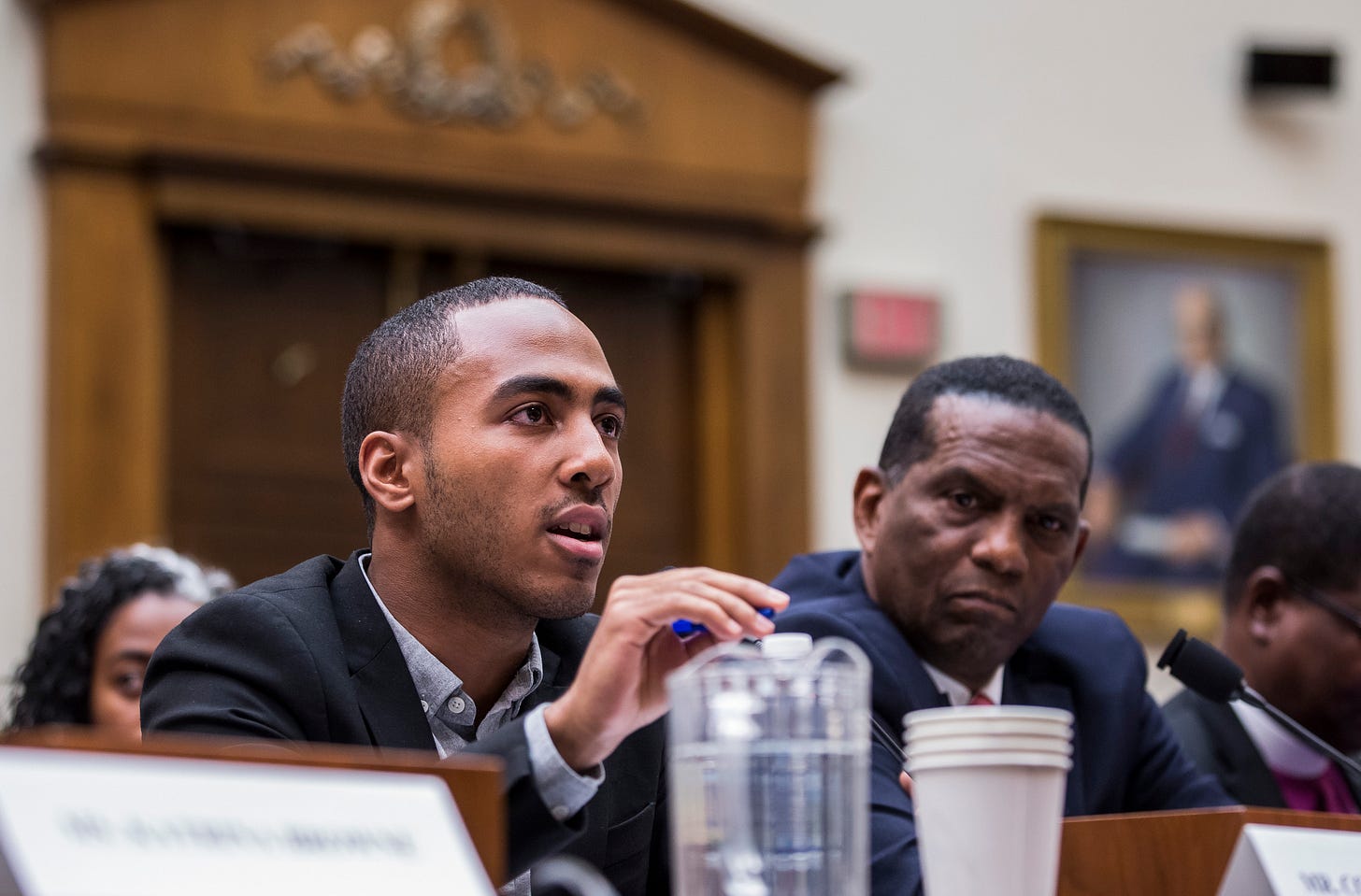Neoracism, Finally On Defense
Coleman Hughes makes a defense of color neutrality in law and politics.

Has the United States ever officially been a color-blind society? You could make a plausible case that it hasn’t. For four centuries, it enshrined enslavement and then segregation of African-Americans, pursued the near-extermination and ethnic cleansing of most Native Americans, and subsequently made “white” racial identity central to its immigration policies. Then, in the mid-1960s, in civil rights and immigration, it finally repudiated this racist regime. The philosophy behind the 1964 Civil Rights Act can be traced back to the abolitionist Wendell Phillips in 1867, who insisted that the end of slavery was not enough:
When once the nation is absolutely, irrevocably pledged to the principle that there shall be no recognition of race by the United States or by State law, then the work of the great anti-slavery movement which commenced in 1831, is accomplished.
This idea was carried forward in 1896 by Justice John Marshall Harlan in his dissent in Plessy v. Ferguson:
Our Constitution is color-blind, and neither knows not tolerates classes among citizens. In respect of civil rights, all citizens are equal before the law. The humblest is the peer of the most powerful.
That dissent was later described by an aide to Thurgood Marshall as the “Bible” to which the great 20th Century jurist turned to in his darkest moments.
But almost as soon as the 1964 breakthrough in overcoming racial classifications took hold, it was abandoned. In a perverse echo of the past, sanctioned preferential treatment for blacks slowly began to replace sanctioned preferential treatment for whites. Set-asides, quotas, affirmative action all proliferated, all rooted in the old, crude racial classifications. The notion that affirmative action was a temporary adjustment, to be retired in a couple of decades at most, gradually disappeared. In fact, it was extended to every other racial or sexual minority and to women. Even as women and many blacks and other minorities triumphed in the economy and mainstream culture, they were nonetheless deemed eternal victims of pervasive misogyny and racism.
The more tangible the success for women and minorities, the more abstract the notion of “systemic oppression” became. Critical race theorists argued that color-blindness itself was a form of racism; and that all white people, consciously or unconsciously, could not help but be perpetuators of racial hate, whether they intended to or not. That’s how we arrived at a moment when Jon Stewart decided he’d tackle the subject of racial inequality in America by hosting a show called “The Problem With White People,” and when “The 1619 Project” actually argued that the American Revolution was not driven by a desire to be free from Britain but to retain slavery, which Britain threatened.
The poignancy of Coleman Hughes’ new book, The End of Race Politics, lies therefore in the tenacity of his faith in the spirit of 1964. “Color-blindness” is not the best description of this, because of course we continue to see others’ race, just as we will always see someone’s sex. No, as Hughes explains: “To advocate colorblindness is to endorse an ethical principle: we should treat people without regard to race, both in our public policy and private lives.”
That’s a principle the vast majority of Americans, black and white and everything else, support. It was the core principle for Frederick Douglass, Zora Neale Hurston, Martin Luther King Jr, and Bayard Rustin. “If I have advocated the cause of the colored people, it is not because I am a negro, but because I am a man,” insisted Douglass. Henry Highland Garnet — the first African-American to speak in Congress after the passage of the Thirteenth Amendment — even apologized for speaking of various different races, “when in fact there is but one race, as there was but one Adam.”
Fast forward to 2015, when the University of California called the phrase “There is only one race, the human race” a “micro-aggression”; or 2020, when the phrase “All Lives Matter” was deemed evidence of “anti-blackness”. The 21st Century, the brief era of color-blindness behind us, reached back to the 19th to insist that race defines us at our core, can never be overcome, and marks us all either an oppressor or a victim. The left, including the Democratic Party, has now adopted this worldview, along with a legal regime to actively discriminate against some races and not others: “equity”. That’s why Hughes cuts to the chase and calls these reactionaries in progressive clothing “neoracists”. They are. What else would one call them?
They are race-obsessed. They view any human interaction as a racial power-struggle, and compound it with any number of further “intersectional” power-struggles. They do not see two unique individuals with unique life experiences interacting in a free society. They see group identity as determinative everywhere; and therefore want to intervene everywhere, to discriminate against whites and successful non-whites in favor of unsuccessful non-whites. Individual rights? They come second to group identity.
I didn’t grow up in America, and didn’t absorb America’s racial obsessions. But I did grow up in a country which similarly obsessed about another kind of group identity, class. Everything was about class, every statement, every accent, every region, every city, every school, and every job. It ate you up; it could destroy all the other possible vectors of connection with other people; and the obsession with it didn’t actually ameliorate it. In some ways, the more you thought about it, the worse it got. It’s why I loved America: rooted in unleashing the unique individual, uninterested in the recent past, let alone four centuries ago, looking forward with optimism as individuals, not looking back with grudges as groups.
This emphasis on the uniqueness of each individual and his or her potential — regardless of which group they are assigned to — is far from dated. In fact, as a society becomes ever more multi-racial and multi-cultural, and racial groupings splinter and proliferate, and mixed-race people increase in number, the individual is the only unit that won’t lead to permanent, irresolvable conflict. The old black-white paradigm to which so many are still attached has been superseded by the kaleidoscope society, in which “race” is almost always mixed, complicated, or one difference among many.
One in five “black” Americans are immigrants or descended from them, Hughes observes. Only 30 percent of Asian-Americans think of themselves as “Asian” at all, rather as a member of a specific group — like Korean or Indian. Within the Asian box, you also have huge diversity: “In 2015, 72 percent of Indians over 25 had at least a bachelors degree. yet only 9 percent of Bhutanese did.” Ditto “Hispanic”. Any formula that conflates Cubans with Mexicans and Colombians is absurd. And don’t get me started on the LGBTQIA+ bullshit.
The woke also have a staggeringly crude understanding of power. Economic power? No doubt many whites have a huge edge in accumulated wealth in America; but the cultural power of African-Americans is global in reach and far outweighs the cultural clout of, say, white evangelicals or conservatives at home. Political power? Blacks, who are about 14 percent of population, are represented proportionally in the House — covering 29 states — and can claim the last two-term president, the current vice president, the House minority leader, the secretary of defense, the chairman of the Joint Chiefs, the mayors of the four most populous cities last year, and more than a fifth of SCOTUS.
For the neoracists, all racial disparities are entirely explained by “systemic racism.” But this obviously obscures the complexity of American society. “Culture” is a loaded and complex term, but it sure matters. A child with two engaged parents in the home has far more chances to succeed than a kid who barely sees his dad. Now look at the difference between family structure among many Asian-American groups and that of black Americans. And how can one blame “white supremacy” for the constant murderous mayhem of urban black spaces? Only by removing from young black men any concept of their own agency and humanity.
So do we do nothing? Not at all. In fact, blaming an abstraction — “white supremacy” — takes us backwards practically and analytically. Hughes advocates for color-blind processes wherever possible: blind grading in schools and colleges; or hiring policies that remove names from applications to deter racism. A classic color-blind policy would be Chicago’s automated CCTV tracking system for gun-shots, ShotSpotter. Gun-shots have no race; getting quick locations for gun-shots saves lives; and yet this week, the woke mayor of Chicago discontinued the technology because the shooters detected, like most violent criminals in Chicago, were mainly black. Ditto SATs. They are designed to be as race-neutral as possible — which is why they have been attacked.
This is Coleman Hughes’ first book. Like him, it’s methodical, clear as a bell, reasoned, and temperate. He’s clearly trying to win an argument, not impress an audience. The prose is stripped of embellishment and rhetoric; it’s focused entirely in its attempt to persuade. I came to the book persuaded, of course, but it’s really not written for me. It’s written for his Gen Z peers of all races; it offers an escape from our dreary race Manichaeism toward a future of individual agency, flourishing, and creativity. It will be a key test for colleges if they assign this book alongside the usual woke screeds, and allow young Americans to see just how much they have been lied to, and how easily they can, if they decide to, turn this thing around.
There’s reason for optimism. Last year, Pew found support for BLM had “dropped considerably from its peak in 2020,” and a majority believe that the “racial reckoning” since 2020 “hasn’t led to improvements for Black Americans.” Affirmative action in higher ed was struck down by SCOTUS, and 68 percent of Americans say that is “mostly a good thing.” Kendi’s “antiracism” center has imploded; the “1619 Project” docu-series was panned by audiences; Robin DiAngelo is roundly mocked; Claudine Gay has resigned; and DEI is waning in corporate America.
But the implosion of bad ideas is not the same as the resuscitation of good ones. What Hughes has done in this book is remind us what we already knew: that racism and neoracism are two sides of the same collectivist coin, and that treating everyone regardless of race is the only feasible way forward for a multiracial America, just as it is the only morally defensible regime that can actually counter and erode racial hatred. The proof is in our past progress. But the potential for multi-racial individualism is as unknowable as it is exhilarating.
Know hope.
(Note to readers: This is an excerpt of The Weekly Dish. If you’re already a subscriber, click here to read the full version. This week’s issue also includes: a long chat with Nate Silver about gambling and politics; many reader dissents over Biden’s age and other topics; eight notable quotes for the week in news, including an Yglesias Award for a newfound critic of a George Floyd film; 22 pieces on Substack we recommend on a wide variety of topics; a Mental Health Break of EDM evensong; a paradisal view of Panama; and, of course, the results of the View From Your Window contest — with a new challenge. Subscribe for the full Dish experience!)
From a Dishhead who renewed his subscription:
I continue to 100% support the independent journalism of the Dish. I agree with you about most things, but even when I disagree with you, or with one of your podcast guests, I appreciate the great open-mindedness and good-natured humor you bring to each conversation.
New On The Dishcast: Nate Silver
Nate is a statistician and writer focused on American politics and sports, and a longtime friend from the blog days. He was the founder and editor-in-chief of FiveThirtyEight, and now he writes his own substack, Silver Bulletin. He’s the author of The Signal and the Noise, and his forthcoming book is On the Edge: How Successful Gamblers and Risk-Takers Think (pre-order here).
Listen to the episode here. There you can find two clips of our convo — on the pluralism of gay social networks, and why poker is so male. That link also takes you to commentary on our episodes with Isikoff and Klaidman on Trump, and Justin Brierley on the renewed belief in God. Plus, more reader debate over Biden’s age, immigration, and transqueer ideology, with my replies throughout.
From a listener who “thoroughly enjoyed your interview with Justin Brierley”:
I’m now reading his new book, The Surprising Rebirth of Belief in God. Excellent. My own rebirth came in my study of quantum mechanics. To grasp the subatomic world is to realize there is order in the universe that is not random, but the work of God.
On the anti-Semitism episode with Jonathan Freedland:
As a British ex-pat living in Israel and somewhat involved in the politics of both countries, I really loved your chat with Freedland. He’s an excellent observer of Israel from the outside and I think much of his analysis was right.
I would, however, recommend that your listeners check out his podcast with Israeli journalist Yonit Levy, “Unholy”, where you really see the difference between a diaspora Jew looking from the outside and an Israeli Jew who lives here and whose children serve (or will serve) in the IDF — even though both of them largely agree on the big political questions.
Being a liberal in Israel means contending with neighbouring countries (including the Palestinian Authority that you seek to make peace with) dominated and run by illiberals. So while it is certainly true that, at present, neither Israelis nor Palestinians have a leadership willing to make the necessary concessions for a two-state solution, it’s also true that when Israel has had those leaders, the Palestinian interlocutor was lacking. A two-state deal would certainly require a change in the Israeli government, but it would require a change in the entire Palestinian national worldview, which has — from before the founding of Israel to the present— been based on the assumption that Israel is a passing phase; that the Jews will be vanquished like other “colonisers” before them. Polls show that only a small minority of Palestinians accept that Israeli Jews see this place as our historic homeland no less than the Palestinians do.
Browse the Dishcast archive for an episode you might enjoy (the first 102 are free in their entirety — subscribe to get everything else). Coming up: Christian Wiman on resisting despair as a Christian, Rob Henderson on class and “luxury beliefs,” Jeffrey Rosen on the Stoics and happiness, George Will on Trump and conservatism, and Abigail Shrier on why the cult of therapy harms children. Please send any guest recs, dissents, and other pod comments to dish@andrewsullivan.com.
The Price Of Tucker Carlson’s Soul
What you also see in that sit-down interview is Tucker Carlson making a series of false comparisons between the US and Hungary, in order to portray Orbàn’s one-party illiberalism as somehow superior to contemporary America. Like Jane Fonda before him, Tucker went to a foreign country to denigrate and smear his own.
(Read the rest of that August 2021 Dish column here. Tucker hasn’t changed, has he?)
Dissents Of The Week: The RBG Syndrome, Ctd
A reader on my latest column:
On the same day that Biden flubbed the “president” of Egypt, Trump made the same mistake with the Prime Minister of Hungary — one of countless flubs that got little coverage. (More importantly, Mike Johnson made the same mistake confusing Israel and Iran.) Did Biden think he was talking to the president of Mexico on the Gaza border? Heck no, and if you listened to the entire remarks, it’s painfully obvious that, in fact, Biden knew exactly what was going on and doesn’t have dementia.
Dementia doesn’t have patches; it’s all consuming. Gaffes and flubs aren’t a sign of dementia. Instead of focusing on gaffes like they’re gospel, I’d rather people follow the reporting we do have on Biden’s interactions, which are many, and they all point roughly towards the same answer: no, Biden does not have dementia; he can do the job; and he’s been pretty damn effective at it.
Read my reply here, along with several other dissents. More debate between readers and me, on this topic and others, here.
In The ‘Stacks
This is a feature in the paid version of the Dish spotlighting about 20 of our favorite pieces from other Substackers every week. This week’s selection covers subjects such as the special election for Santos’ seat, the by-elections in Britain, and polyamory. Below are a few examples:
A debate over male horniness and female neediness, continued here.
Evan Marc Katz, a dating coach, addresses the question, “Is it racist to have racial preferences in dating?”
If you have any recommendations for “In the ‘Stacks,” especially ones from emerging writers, please let us know: dish@andrewsullivan.com. From an emerging writer:
I just wanted to say a quick thank you or inspiring me to take a recent leap. I’ve been a reader for about ten years, and during that decade of Dishness, I sometimes flirted with the idea of trying to be an independent writer, but never did anything about it — until last month! I finally launched a substack. It’s dedicated to a central passion of mine: blues music. My plan is to publish essays and original blues lyrics, and hopefully launch a podcast someday. Here’s my first post/mission statement. I probably wouldn’t have done this without your example of what writing online can be.
That makes me very happy. Check it out!
The View From Your Window Contest
Where do you think it’s located? Email your guess to contest@andrewsullivan.com. Please put the location — city and/or state first, then country — in the subject line. Proximity counts if no one gets the exact spot. Bonus points for fun facts and stories. The deadline for entries is Wednesday night at midnight (PST). The winner gets the choice of a VFYW book or two annual Dish subscriptions. If you are not a subscriber, please indicate that status in your entry and we will give you a free month subscription if we select your entry for the contest results (example here if you’re new to the contest). Happy sleuthing!
The results for this week’s window are coming in a separate email to paid subscribers later today. A previous winner on Vashon Island writes, “Props to the photographer for including an ‘impression’ of themself in the photo.” That little mystery is solved by the super-champ in Berkeley:
Apparently a familiar fiend took this week’s photograph:
Half of this photo is an empty roof. A third of it’s sky. Almost a third of the landscape to the left is effectively invisible because of a blinding sunset and filthy glass. The rest is obscured by gathering darkness BECAUSE THAT’S WHAT HAPPENS WHEN THE SUN GOES DOWN.
Honestly! I needed to chop off a third of the photo just to keep from being blinded when I boosted the exposure level to a point where I could make out that the dark area was little more than random pixels because the camera was focused on the foreground roof ventilation fans!
See you next Friday.





